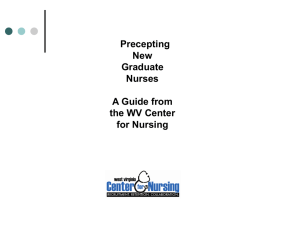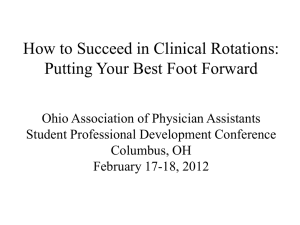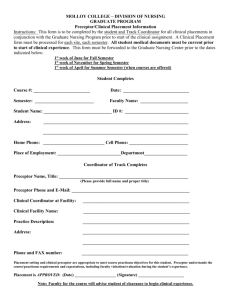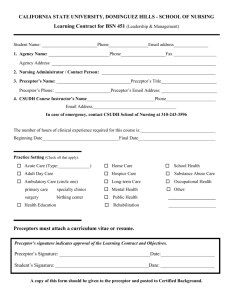Clinical Journal II - Georgetown Digital Commons
advertisement
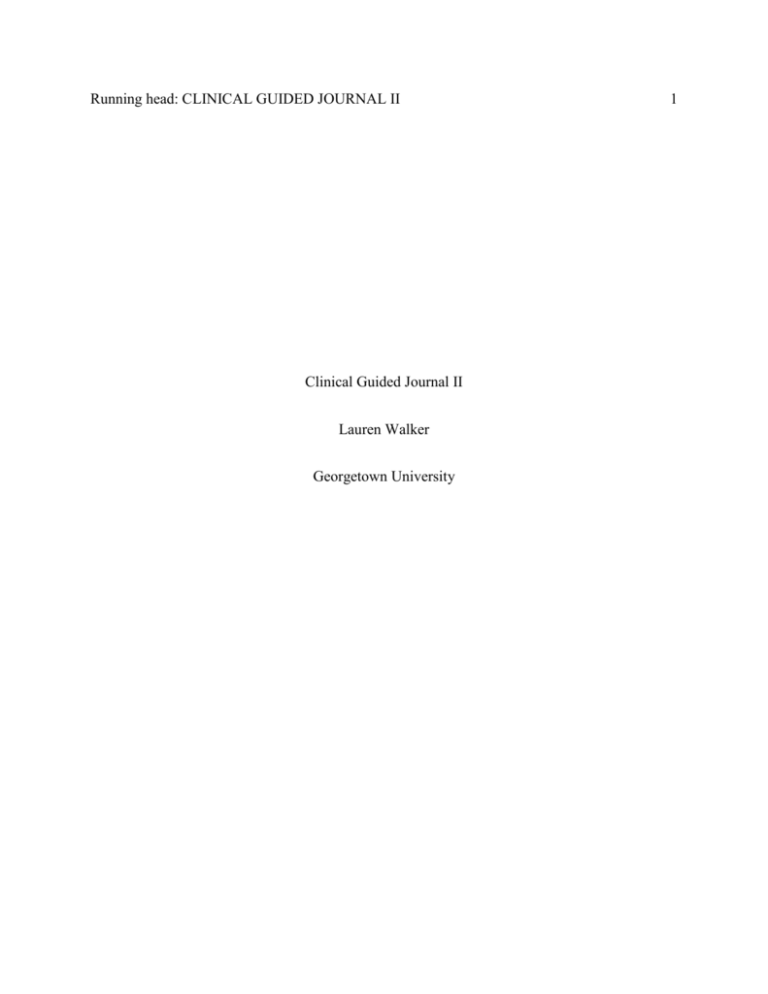
Running head: CLINICAL GUIDED JOURNAL II Clinical Guided Journal II Lauren Walker Georgetown University 1 CLINICAL GUIDED JOURNAL II Health care is continually changing. In the inpatient setting, Advanced Practice Nurses continually work to keep up with the changes in health care and are faced with many responsibilities to bring best practice to the bedside for the benefit of providers and patients. To influence change Becker, Kaplow, Muenzen and Hartigan (2006), state that the Synergy Model for Patient Care is based on the premise that certified practice is more than tasks and should be grounded in nurses meeting the needs of patients and optimizing patient’s outcomes. To optimize patient outcomes a component of the Synergy Model, clinical inquiry, enables the APN to explore, interpret and enhance clinical practice to optimize by strengthening patient characteristics and nurse competencies. Cohen, Crego, Cuming, and Smyth (2002), state “With the rapid advances in healthcare knowledge, clinical inquiry is more important than ever before”. Clinical Inquiry, as defined by a presentation given by Kesten (2011), is the ongoing process of questioning and evaluating practice and providing informed practice; creating practice changes through research utilization and experiential learning. Kesten (2011) also states that CNS practice requires the ability to understand and synthesize multiple perspectives, to be aware of personal thinking patterns and to make prudent and effective decisions that enhance nursing practice and positively influence quality and cost effectiveness. The characteristic of clinical inquiry is evident through the actions of a preceptor in the Neurosciences ICU (NSICU). The components of clinical inquiry evolve around the concepts of research and evidence based practice. Research is a necessary component used by the preceptor in situations in which more information is needed to determine if his staff is following best practice. By performing a literature search and using learned information, he is able to evaluate and model best practice standards. A research investigation is first initiated by questioning and 2 CLINICAL GUIDED JOURNAL II evaluating if the NSICU’s practice, current outcomes and procedures are the best technique for optimal outcomes. This questioning techniques and evaluation of outcomes has enabled the preceptor to research practice guidelines specific for his unit. For example the NSICU was having high rates of urine catheter associated UTIs. The preceptor performed a literature search and created a national query on the topic for Foley catheter management and was able to develop and manage decision making tree for Foley catheter management. The NSICU was also having a trial of new Lumbar Drain devices. Nurses were not clear on the use and proper procedure in routine care. The preceptor was able to model best research practice by performing a through literature review and comparing the units standards to the American Association of Neurosurgical Nurses. The research enabled the preceptor to compare his NSICU practice to evidence-based outcomes. With a restructuring of the NSICU procedures, the preceptor educates and models evidence-based practice to impact the nurse to nurse sphere to provide enhanced outcomes. The patient and family sphere is then impacted through the actions of the CNS through receiving evidence based care practiced by the medical team. With optimal Foley catheter management, the system, therefore, has decreased rates of catheter associated UTIs. The preceptor also recognizes that research has the reputation of being dry and boring, and therefore works hard to excite and include his staff in the process of clinical inquiry. Staff in the NSICU actively participates in a Journal Club. Each month, a nurse presents an article on a topic that directly impacts their unit and patient population. The group then discusses how they can use this information in their ICU to positively impact their patients and enhance nursing skill. The preceptor also actively engages in IRB research projects. Recently, the preceptor included his nurses in an IRB approved study on the influence on nursing interventions on 3 CLINICAL GUIDED JOURNAL II changes in intracranial pressure. Nurses were eager to send in their data to be evaluated and look forward to the outcomes of the project. By modeling clinical inquiry and involving the team, the nurse to nurse sphere was impacted as they will use this data to influence their care in the clinical setting with their patients. White (2004), states that by bringing research to the bedside is difficult because of the resistance to staff. The preceptor did verbalize many times that it is hard to initiate change in the ICU. He stated that it sometimes easier to educate and implement new practice techniques with newer staff, since they are still learning and eager to know what is considered best practice. However, it is very difficult to implement changes with resident MD, Physician Assistants (PA), attending physicians or older nurses. The preceptor stated that resident MD and PAs will follow what the Attending Physician tells them to do and are not likely to stray from that direction. It is also harder to incorporate change with a seasoned nurse or attending physician since they have established their own specific technique for management which has worked for them. As a novice CCNS, it is essential and a top priority to uphold and incorporate the components of clinical inquiry in the clinical setting. The spheres of influence according to the Synergy Model are essential when recognizing the needs within a system. (Becker et al., (2006), describe that the central concept is that the needs or characteristics of patients and patient’s families influence and drive the characteristics or competencies of nurses. Therefore, it is a top priority to provide well educated, up to date and best practice to meet the demands and needs of the patient. In the process of clinical inquiry and making sure that nurses are meeting patient needs, it is essential for the CCNS to foster enthusiasm for research by facilitating the understanding of research and involving the staff (Cohen et al., 2002). Through the evaluation of the preceptor’s actions, it is clear that a novice CCNS can continue the tradition of clinical 4 CLINICAL GUIDED JOURNAL II inquiry to enhance evidence-based practice with the nurse-nurse sphere of influence by the involvement of the staff. Clinical inquiry also holds a high value when compared to the other characteristics of the Synergy Model. All characteristics are supported and impacted from clinical inquiry. The process of providing validated evidence and data structures how you support, educate and interact with patients, families, and staff. Modeled after the preceptor, evidence based practice (EBP) is also used by the novice CCNS through the development of clinical policies and procedures, in the influence of system wide standards, and through the approach to and care of the patient. The novice CNS will also encourage the use of EBP with the clinical team through clinical advancement research, and recognition and celebration of scholarly accomplishments of the team and perform evidence based literature searches (Becker et al., 2006). White (2004) also notes the importance of the novice CCNS to being a “change agent” by combining ideas from unconnected sources and energizing others by keeping the interest level up and demonstrate high personal energy, communication skills, and problem-solving. When bringing new ideas and change to the bedside, it is essential for the novice CCNS to have realistic thinking regarding how quickly staff will accept and perform new processes as well as the ability to handle resistance to a new process (White, 2004). By upholding the practice and implementation of clinical inquiry, positive changes can be made on the unit to affect the nurse, patient and system. 5 CLINICAL GUIDED JOURNAL II 6 References Becker, D., Kaplow, R., Muenzen, P., & Hartigan, C. (2006). Activities performed by acute and critical care advanced practice nurses: American association of critical-care nurses study of practice. American Journal of Critical Care, 15(2), 130-148. Cohen, S., Crego, N., Cuming, R., & Smyth, M. (2002). The synergy model and the role of the clinical nurse specialists in a multihospital system. American Journal of Critical Care, 11(5), 436-446. Kesten, K. (2011, October). Synergy model APN application: Clinical inquiry. Lecture conducted from Georgetown University, Washington, DC. White, A. (2004). Change strategies make for smooth transitions. Nurse Management, 35(2), 4952.
